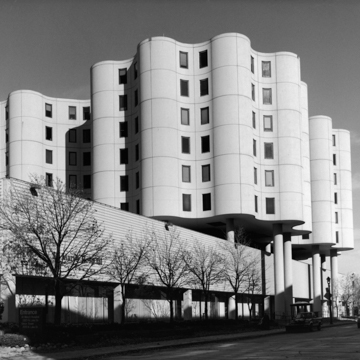This hospital features a six-story tower of undulating walls raised on piers over a two-story rectangular block. The building’s free-form, sculptural character illustrates the fluidity of design that is possible using poured concrete construction. The eye-catching tower’s flower petal ground plan, borrowed from Goldberg’s other hospital projects in Chicago and Tacoma, Washington, is one of the better-known modern structures in the city. Builders used poured concrete primarily for foundations, floors, paving, and industrial applications in the first half of the twentieth century, but after World War II, architects capitalized on the limitless and expressive design effects that concrete makes possible. In this building the curved walls allow more views of Lake Michigan for patient rooms than would be possible with rectangular structures of similar size. Goldberg worked with nursing staff to design the size of each floor’s nursing pods and patient-nurse ratios, and to incorporate efficient systems for food and linen delivery and trash disposal.
You are here
Columbia St. Mary’s Hospital (St. Mary’s Hospital)
If SAH Archipedia has been useful to you, please consider supporting it.
SAH Archipedia tells the story of the United States through its buildings, landscapes, and cities. This freely available resource empowers the public with authoritative knowledge that deepens their understanding and appreciation of the built environment. But the Society of Architectural Historians, which created SAH Archipedia with University of Virginia Press, needs your support to maintain the high-caliber research, writing, photography, cartography, editing, design, and programming that make SAH Archipedia a trusted online resource available to all who value the history of place, heritage tourism, and learning.





















